Contract Formation Steps in Business Law
VerifiedAdded on 2023/01/18
|7
|1915
|69
AI Summary
This document discusses the steps involved in contract formation in business law, including offer, acceptance, consideration, and intention to enter into legal relations. It also explores the enforceability of exclusion clauses and the implications of the Australian Consumer Law.
Contribute Materials
Your contribution can guide someone’s learning journey. Share your
documents today.
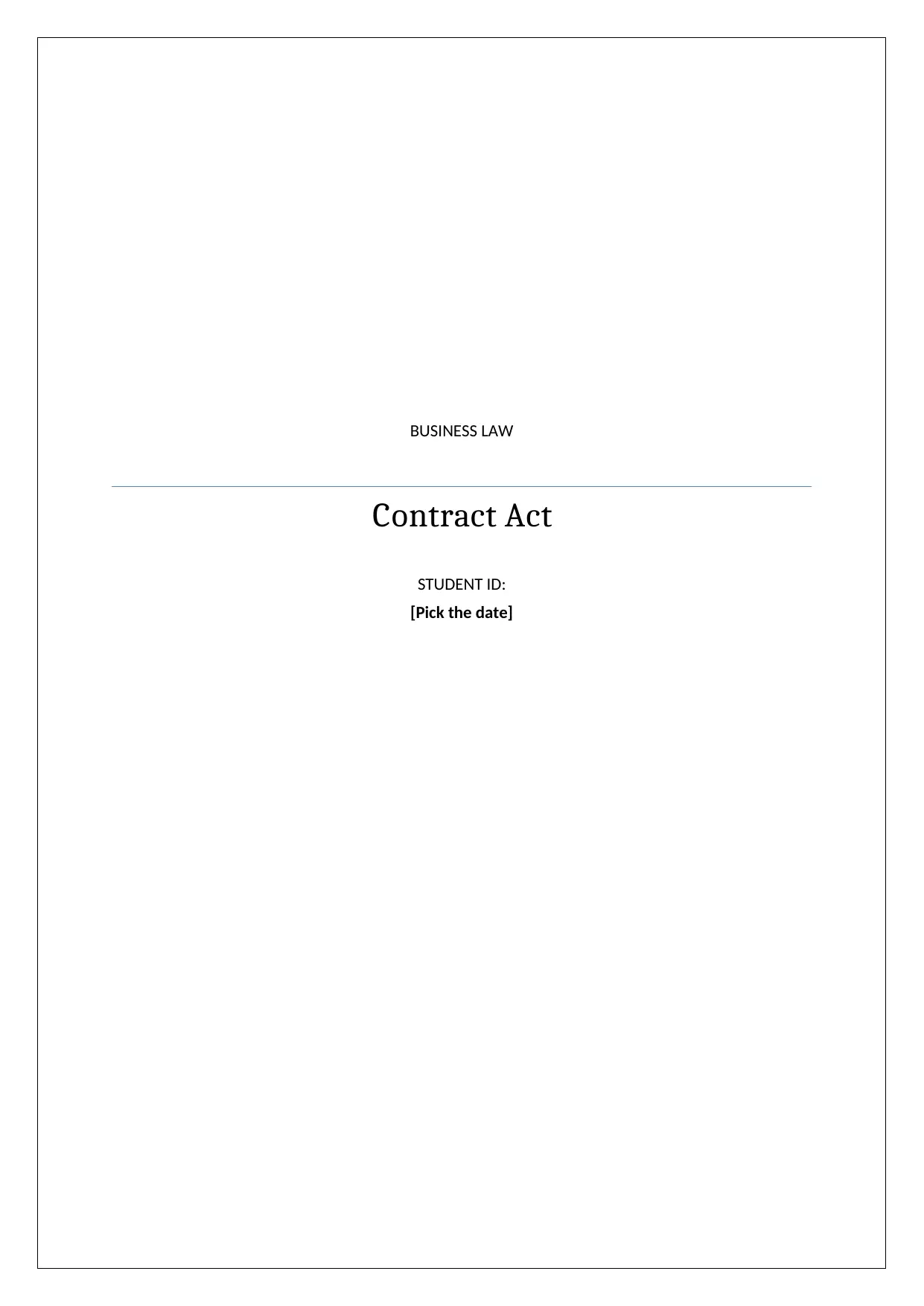
BUSINESS LAW
Contract Act
STUDENT ID:
[Pick the date]
Contract Act
STUDENT ID:
[Pick the date]
Secure Best Marks with AI Grader
Need help grading? Try our AI Grader for instant feedback on your assignments.
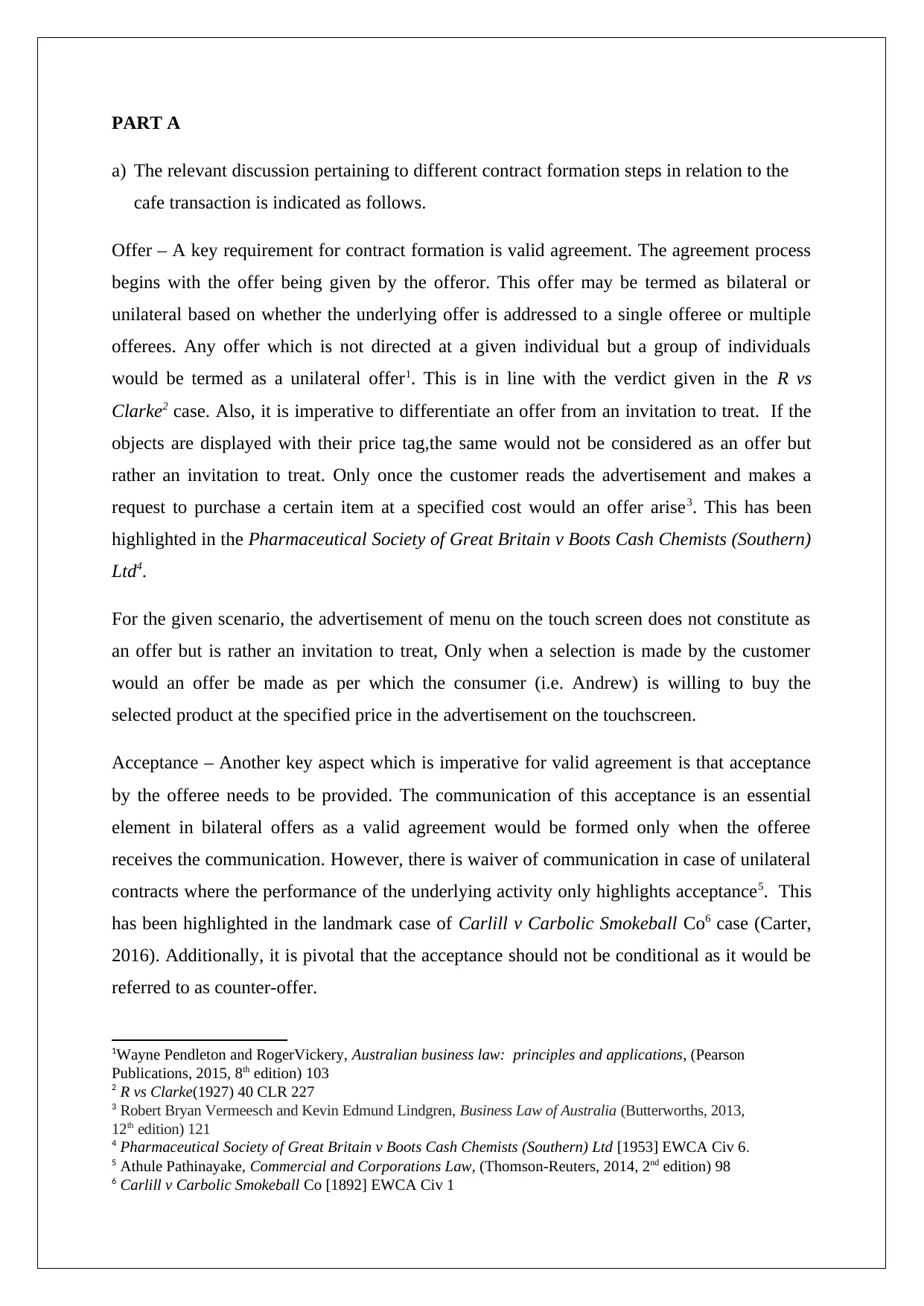
PART A
a) The relevant discussion pertaining to different contract formation steps in relation to the
cafe transaction is indicated as follows.
Offer – A key requirement for contract formation is valid agreement. The agreement process
begins with the offer being given by the offeror. This offer may be termed as bilateral or
unilateral based on whether the underlying offer is addressed to a single offeree or multiple
offerees. Any offer which is not directed at a given individual but a group of individuals
would be termed as a unilateral offer1. This is in line with the verdict given in the R vs
Clarke2 case. Also, it is imperative to differentiate an offer from an invitation to treat. If the
objects are displayed with their price tag,the same would not be considered as an offer but
rather an invitation to treat. Only once the customer reads the advertisement and makes a
request to purchase a certain item at a specified cost would an offer arise3. This has been
highlighted in the Pharmaceutical Society of Great Britain v Boots Cash Chemists (Southern)
Ltd4.
For the given scenario, the advertisement of menu on the touch screen does not constitute as
an offer but is rather an invitation to treat, Only when a selection is made by the customer
would an offer be made as per which the consumer (i.e. Andrew) is willing to buy the
selected product at the specified price in the advertisement on the touchscreen.
Acceptance – Another key aspect which is imperative for valid agreement is that acceptance
by the offeree needs to be provided. The communication of this acceptance is an essential
element in bilateral offers as a valid agreement would be formed only when the offeree
receives the communication. However, there is waiver of communication in case of unilateral
contracts where the performance of the underlying activity only highlights acceptance5. This
has been highlighted in the landmark case of Carlill v Carbolic Smokeball Co6 case (Carter,
2016). Additionally, it is pivotal that the acceptance should not be conditional as it would be
referred to as counter-offer.
1Wayne Pendleton and RogerVickery, Australian business law: principles and applications, (Pearson
Publications, 2015, 8th edition) 103
2 R vs Clarke(1927) 40 CLR 227
3 Robert Bryan Vermeesch and Kevin Edmund Lindgren, Business Law of Australia (Butterworths, 2013,
12th edition) 121
4 Pharmaceutical Society of Great Britain v Boots Cash Chemists (Southern) Ltd [1953] EWCA Civ 6.
5 Athule Pathinayake, Commercial and Corporations Law, (Thomson-Reuters, 2014, 2nd edition) 98
6 Carlill v Carbolic Smokeball Co [1892] EWCA Civ 1
a) The relevant discussion pertaining to different contract formation steps in relation to the
cafe transaction is indicated as follows.
Offer – A key requirement for contract formation is valid agreement. The agreement process
begins with the offer being given by the offeror. This offer may be termed as bilateral or
unilateral based on whether the underlying offer is addressed to a single offeree or multiple
offerees. Any offer which is not directed at a given individual but a group of individuals
would be termed as a unilateral offer1. This is in line with the verdict given in the R vs
Clarke2 case. Also, it is imperative to differentiate an offer from an invitation to treat. If the
objects are displayed with their price tag,the same would not be considered as an offer but
rather an invitation to treat. Only once the customer reads the advertisement and makes a
request to purchase a certain item at a specified cost would an offer arise3. This has been
highlighted in the Pharmaceutical Society of Great Britain v Boots Cash Chemists (Southern)
Ltd4.
For the given scenario, the advertisement of menu on the touch screen does not constitute as
an offer but is rather an invitation to treat, Only when a selection is made by the customer
would an offer be made as per which the consumer (i.e. Andrew) is willing to buy the
selected product at the specified price in the advertisement on the touchscreen.
Acceptance – Another key aspect which is imperative for valid agreement is that acceptance
by the offeree needs to be provided. The communication of this acceptance is an essential
element in bilateral offers as a valid agreement would be formed only when the offeree
receives the communication. However, there is waiver of communication in case of unilateral
contracts where the performance of the underlying activity only highlights acceptance5. This
has been highlighted in the landmark case of Carlill v Carbolic Smokeball Co6 case (Carter,
2016). Additionally, it is pivotal that the acceptance should not be conditional as it would be
referred to as counter-offer.
1Wayne Pendleton and RogerVickery, Australian business law: principles and applications, (Pearson
Publications, 2015, 8th edition) 103
2 R vs Clarke(1927) 40 CLR 227
3 Robert Bryan Vermeesch and Kevin Edmund Lindgren, Business Law of Australia (Butterworths, 2013,
12th edition) 121
4 Pharmaceutical Society of Great Britain v Boots Cash Chemists (Southern) Ltd [1953] EWCA Civ 6.
5 Athule Pathinayake, Commercial and Corporations Law, (Thomson-Reuters, 2014, 2nd edition) 98
6 Carlill v Carbolic Smokeball Co [1892] EWCA Civ 1
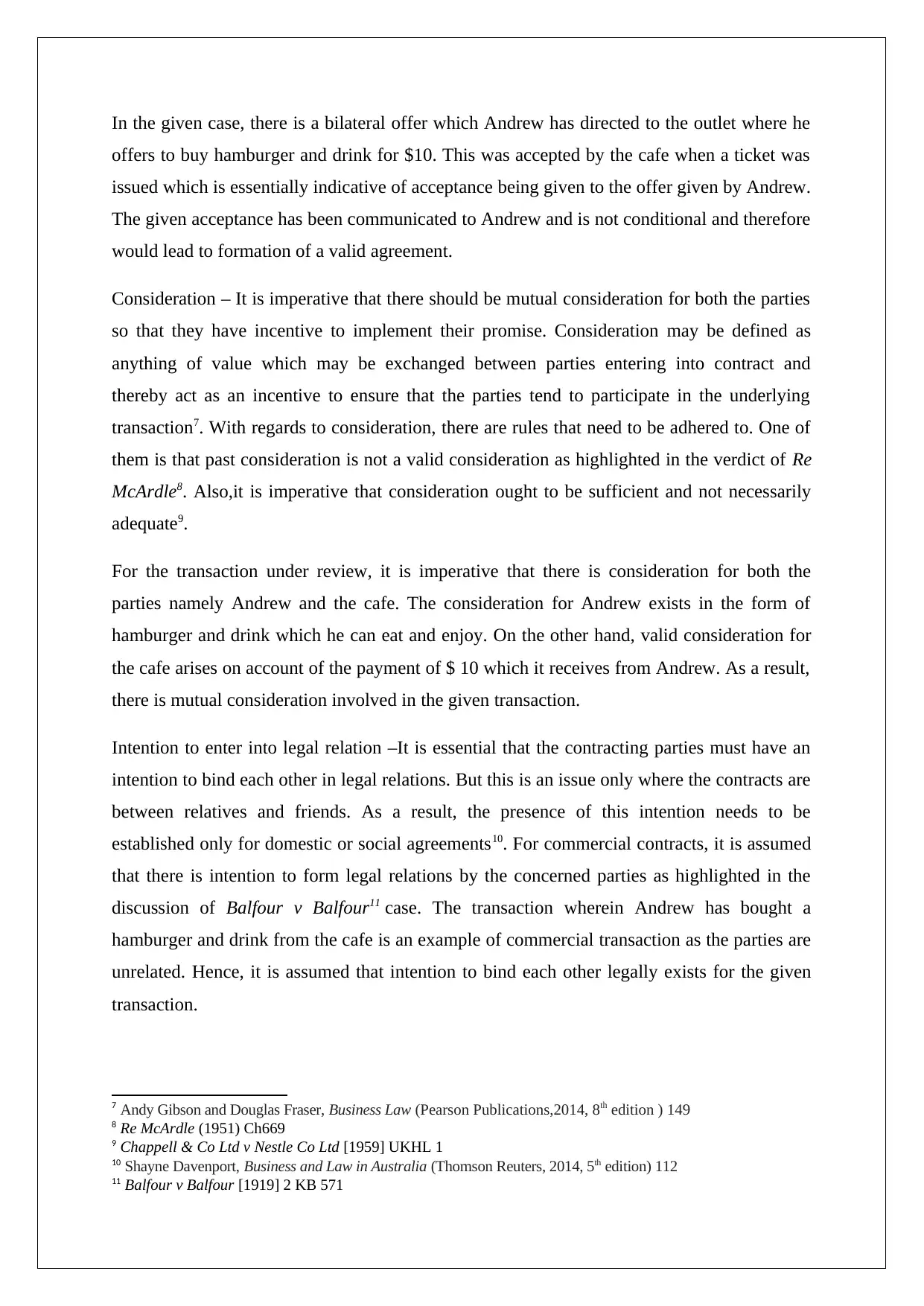
In the given case, there is a bilateral offer which Andrew has directed to the outlet where he
offers to buy hamburger and drink for $10. This was accepted by the cafe when a ticket was
issued which is essentially indicative of acceptance being given to the offer given by Andrew.
The given acceptance has been communicated to Andrew and is not conditional and therefore
would lead to formation of a valid agreement.
Consideration – It is imperative that there should be mutual consideration for both the parties
so that they have incentive to implement their promise. Consideration may be defined as
anything of value which may be exchanged between parties entering into contract and
thereby act as an incentive to ensure that the parties tend to participate in the underlying
transaction7. With regards to consideration, there are rules that need to be adhered to. One of
them is that past consideration is not a valid consideration as highlighted in the verdict of Re
McArdle8. Also,it is imperative that consideration ought to be sufficient and not necessarily
adequate9.
For the transaction under review, it is imperative that there is consideration for both the
parties namely Andrew and the cafe. The consideration for Andrew exists in the form of
hamburger and drink which he can eat and enjoy. On the other hand, valid consideration for
the cafe arises on account of the payment of $ 10 which it receives from Andrew. As a result,
there is mutual consideration involved in the given transaction.
Intention to enter into legal relation –It is essential that the contracting parties must have an
intention to bind each other in legal relations. But this is an issue only where the contracts are
between relatives and friends. As a result, the presence of this intention needs to be
established only for domestic or social agreements10. For commercial contracts, it is assumed
that there is intention to form legal relations by the concerned parties as highlighted in the
discussion of Balfour v Balfour11 case. The transaction wherein Andrew has bought a
hamburger and drink from the cafe is an example of commercial transaction as the parties are
unrelated. Hence, it is assumed that intention to bind each other legally exists for the given
transaction.
7 Andy Gibson and Douglas Fraser, Business Law (Pearson Publications,2014, 8th edition ) 149
8 Re McArdle (1951) Ch669
9 Chappell & Co Ltd v Nestle Co Ltd [1959] UKHL 1
10 Shayne Davenport, Business and Law in Australia (Thomson Reuters, 2014, 5th edition) 112
11 Balfour v Balfour [1919] 2 KB 571
offers to buy hamburger and drink for $10. This was accepted by the cafe when a ticket was
issued which is essentially indicative of acceptance being given to the offer given by Andrew.
The given acceptance has been communicated to Andrew and is not conditional and therefore
would lead to formation of a valid agreement.
Consideration – It is imperative that there should be mutual consideration for both the parties
so that they have incentive to implement their promise. Consideration may be defined as
anything of value which may be exchanged between parties entering into contract and
thereby act as an incentive to ensure that the parties tend to participate in the underlying
transaction7. With regards to consideration, there are rules that need to be adhered to. One of
them is that past consideration is not a valid consideration as highlighted in the verdict of Re
McArdle8. Also,it is imperative that consideration ought to be sufficient and not necessarily
adequate9.
For the transaction under review, it is imperative that there is consideration for both the
parties namely Andrew and the cafe. The consideration for Andrew exists in the form of
hamburger and drink which he can eat and enjoy. On the other hand, valid consideration for
the cafe arises on account of the payment of $ 10 which it receives from Andrew. As a result,
there is mutual consideration involved in the given transaction.
Intention to enter into legal relation –It is essential that the contracting parties must have an
intention to bind each other in legal relations. But this is an issue only where the contracts are
between relatives and friends. As a result, the presence of this intention needs to be
established only for domestic or social agreements10. For commercial contracts, it is assumed
that there is intention to form legal relations by the concerned parties as highlighted in the
discussion of Balfour v Balfour11 case. The transaction wherein Andrew has bought a
hamburger and drink from the cafe is an example of commercial transaction as the parties are
unrelated. Hence, it is assumed that intention to bind each other legally exists for the given
transaction.
7 Andy Gibson and Douglas Fraser, Business Law (Pearson Publications,2014, 8th edition ) 149
8 Re McArdle (1951) Ch669
9 Chappell & Co Ltd v Nestle Co Ltd [1959] UKHL 1
10 Shayne Davenport, Business and Law in Australia (Thomson Reuters, 2014, 5th edition) 112
11 Balfour v Balfour [1919] 2 KB 571

PART B
Issue
The key legal issue is to determine if the exclusion clause printed on the ticket would be
enforceable or not. Also, it needs to be determined if the conduct of cafe has breached any
implied warranty available under the Australian Consumer Law (ACL). Another factor to
consider is whether Andrew is a consumer or not under s.3 of the ACL.
Rule
An exclusion clause is defined as a term in the contract whose purpose is to exempt the
inserting party from liability under specifie pre-defined events. The exclusion clause would
be considered enforceable only if the following conditions are fulfilled12.
The exclusion clause needs to be communicated to the other party before contract
execution
A key requirement for the exclusion clause to be considered valid is that the same ought to be
communicated to the other party before the contract is executed. This allows the other party
to provide an informed consent about the clause so that it may be included in the contractual
terms. However, it is noteworthy that the inserting party sought to take all necessary efforts
to bring the exclusion clause to the notice of the other party. If the other party still does not
read the exclusion clause, it would still be considered enforceable13. A relevant case law
pertaining to the application of exclusion clause is Thornton v Shoe Lane Parking14 whereby
the court held that the exclusion clause was invalid as the parking ticket was offered only
after the car was parked. Hence, no communication of exclusion clause was done before the
contract enactment. As a result, it was not considered enforceable (Davenport and Parker,
2014).
Exclusion clause ought to be legal
It is essential that the exclusion clause should not violate any statutory provision. If this is the
case or exclusion clause has been inserted with malign intent, then it would not be considered
as valid15.
12 Ibid 1,139
13 Ibid 3, 114
14 Thornton v Shoe Lane Parking [1971] 1 All ER 686
15 Ibid. 5, 123
Issue
The key legal issue is to determine if the exclusion clause printed on the ticket would be
enforceable or not. Also, it needs to be determined if the conduct of cafe has breached any
implied warranty available under the Australian Consumer Law (ACL). Another factor to
consider is whether Andrew is a consumer or not under s.3 of the ACL.
Rule
An exclusion clause is defined as a term in the contract whose purpose is to exempt the
inserting party from liability under specifie pre-defined events. The exclusion clause would
be considered enforceable only if the following conditions are fulfilled12.
The exclusion clause needs to be communicated to the other party before contract
execution
A key requirement for the exclusion clause to be considered valid is that the same ought to be
communicated to the other party before the contract is executed. This allows the other party
to provide an informed consent about the clause so that it may be included in the contractual
terms. However, it is noteworthy that the inserting party sought to take all necessary efforts
to bring the exclusion clause to the notice of the other party. If the other party still does not
read the exclusion clause, it would still be considered enforceable13. A relevant case law
pertaining to the application of exclusion clause is Thornton v Shoe Lane Parking14 whereby
the court held that the exclusion clause was invalid as the parking ticket was offered only
after the car was parked. Hence, no communication of exclusion clause was done before the
contract enactment. As a result, it was not considered enforceable (Davenport and Parker,
2014).
Exclusion clause ought to be legal
It is essential that the exclusion clause should not violate any statutory provision. If this is the
case or exclusion clause has been inserted with malign intent, then it would not be considered
as valid15.
12 Ibid 1,139
13 Ibid 3, 114
14 Thornton v Shoe Lane Parking [1971] 1 All ER 686
15 Ibid. 5, 123
Secure Best Marks with AI Grader
Need help grading? Try our AI Grader for instant feedback on your assignments.
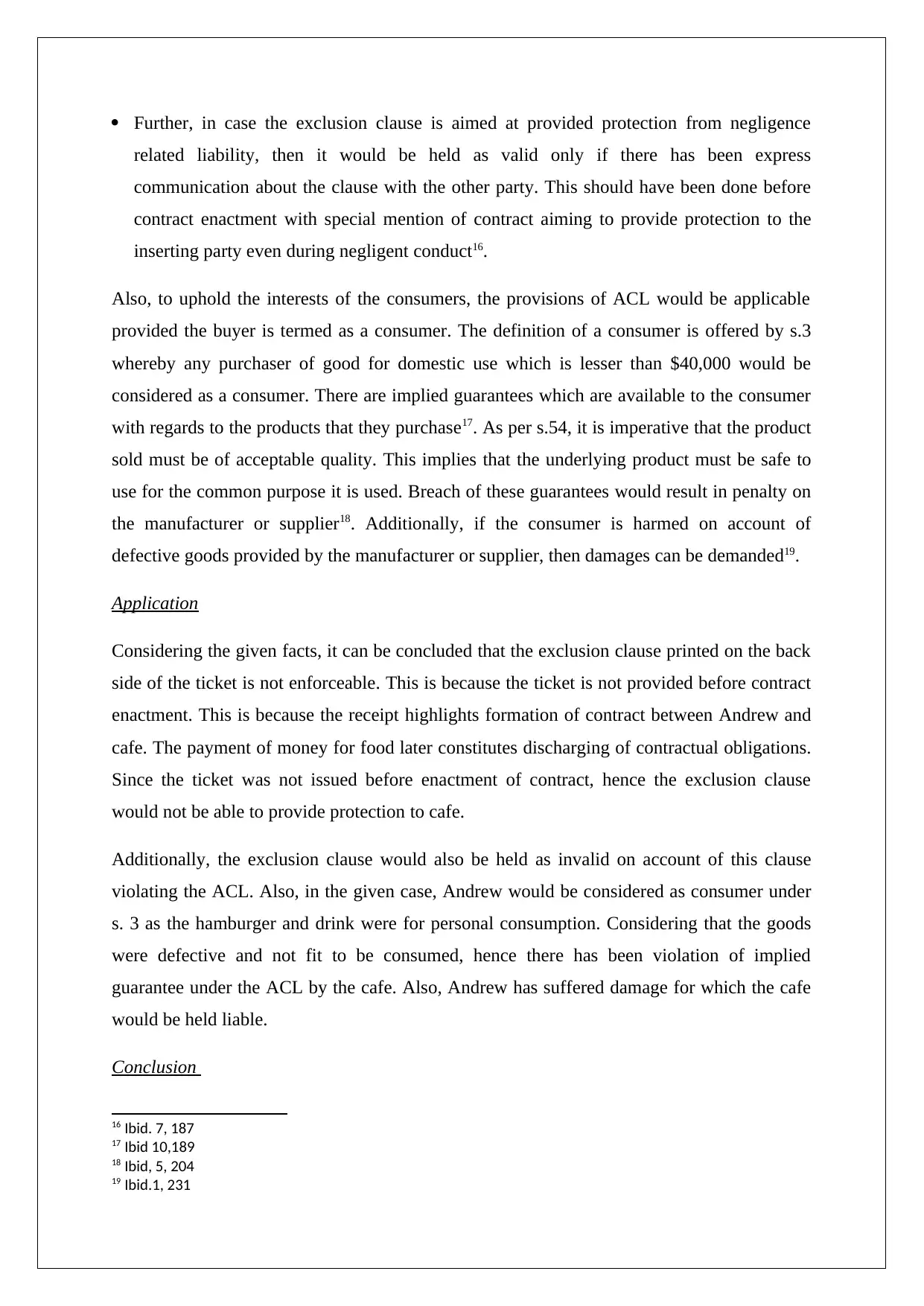
Further, in case the exclusion clause is aimed at provided protection from negligence
related liability, then it would be held as valid only if there has been express
communication about the clause with the other party. This should have been done before
contract enactment with special mention of contract aiming to provide protection to the
inserting party even during negligent conduct16.
Also, to uphold the interests of the consumers, the provisions of ACL would be applicable
provided the buyer is termed as a consumer. The definition of a consumer is offered by s.3
whereby any purchaser of good for domestic use which is lesser than $40,000 would be
considered as a consumer. There are implied guarantees which are available to the consumer
with regards to the products that they purchase17. As per s.54, it is imperative that the product
sold must be of acceptable quality. This implies that the underlying product must be safe to
use for the common purpose it is used. Breach of these guarantees would result in penalty on
the manufacturer or supplier18. Additionally, if the consumer is harmed on account of
defective goods provided by the manufacturer or supplier, then damages can be demanded19.
Application
Considering the given facts, it can be concluded that the exclusion clause printed on the back
side of the ticket is not enforceable. This is because the ticket is not provided before contract
enactment. This is because the receipt highlights formation of contract between Andrew and
cafe. The payment of money for food later constitutes discharging of contractual obligations.
Since the ticket was not issued before enactment of contract, hence the exclusion clause
would not be able to provide protection to cafe.
Additionally, the exclusion clause would also be held as invalid on account of this clause
violating the ACL. Also, in the given case, Andrew would be considered as consumer under
s. 3 as the hamburger and drink were for personal consumption. Considering that the goods
were defective and not fit to be consumed, hence there has been violation of implied
guarantee under the ACL by the cafe. Also, Andrew has suffered damage for which the cafe
would be held liable.
Conclusion
16 Ibid. 7, 187
17 Ibid 10,189
18 Ibid, 5, 204
19 Ibid.1, 231
related liability, then it would be held as valid only if there has been express
communication about the clause with the other party. This should have been done before
contract enactment with special mention of contract aiming to provide protection to the
inserting party even during negligent conduct16.
Also, to uphold the interests of the consumers, the provisions of ACL would be applicable
provided the buyer is termed as a consumer. The definition of a consumer is offered by s.3
whereby any purchaser of good for domestic use which is lesser than $40,000 would be
considered as a consumer. There are implied guarantees which are available to the consumer
with regards to the products that they purchase17. As per s.54, it is imperative that the product
sold must be of acceptable quality. This implies that the underlying product must be safe to
use for the common purpose it is used. Breach of these guarantees would result in penalty on
the manufacturer or supplier18. Additionally, if the consumer is harmed on account of
defective goods provided by the manufacturer or supplier, then damages can be demanded19.
Application
Considering the given facts, it can be concluded that the exclusion clause printed on the back
side of the ticket is not enforceable. This is because the ticket is not provided before contract
enactment. This is because the receipt highlights formation of contract between Andrew and
cafe. The payment of money for food later constitutes discharging of contractual obligations.
Since the ticket was not issued before enactment of contract, hence the exclusion clause
would not be able to provide protection to cafe.
Additionally, the exclusion clause would also be held as invalid on account of this clause
violating the ACL. Also, in the given case, Andrew would be considered as consumer under
s. 3 as the hamburger and drink were for personal consumption. Considering that the goods
were defective and not fit to be consumed, hence there has been violation of implied
guarantee under the ACL by the cafe. Also, Andrew has suffered damage for which the cafe
would be held liable.
Conclusion
16 Ibid. 7, 187
17 Ibid 10,189
18 Ibid, 5, 204
19 Ibid.1, 231
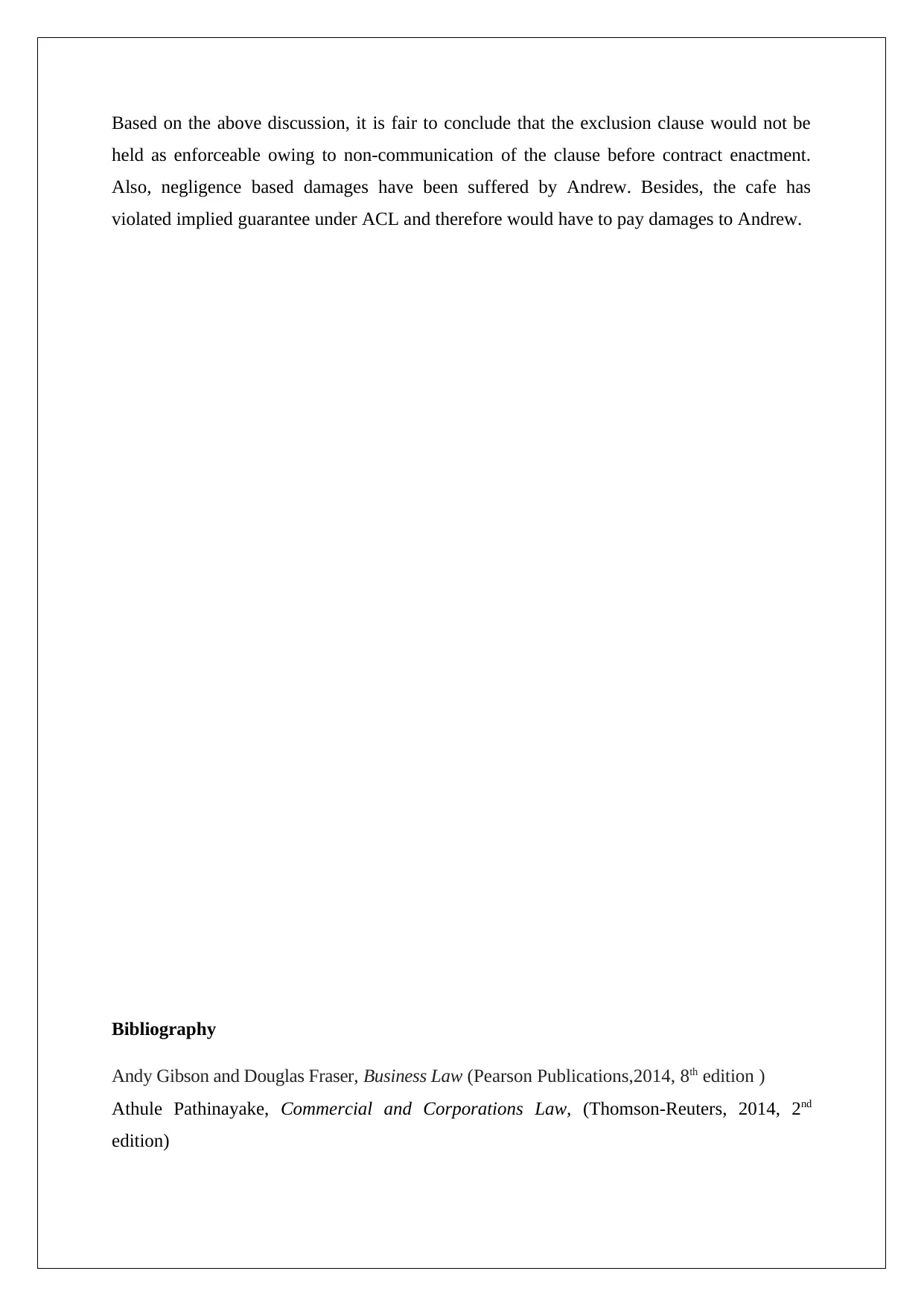
Based on the above discussion, it is fair to conclude that the exclusion clause would not be
held as enforceable owing to non-communication of the clause before contract enactment.
Also, negligence based damages have been suffered by Andrew. Besides, the cafe has
violated implied guarantee under ACL and therefore would have to pay damages to Andrew.
Bibliography
Andy Gibson and Douglas Fraser, Business Law (Pearson Publications,2014, 8th edition )
Athule Pathinayake, Commercial and Corporations Law, (Thomson-Reuters, 2014, 2nd
edition)
held as enforceable owing to non-communication of the clause before contract enactment.
Also, negligence based damages have been suffered by Andrew. Besides, the cafe has
violated implied guarantee under ACL and therefore would have to pay damages to Andrew.
Bibliography
Andy Gibson and Douglas Fraser, Business Law (Pearson Publications,2014, 8th edition )
Athule Pathinayake, Commercial and Corporations Law, (Thomson-Reuters, 2014, 2nd
edition)
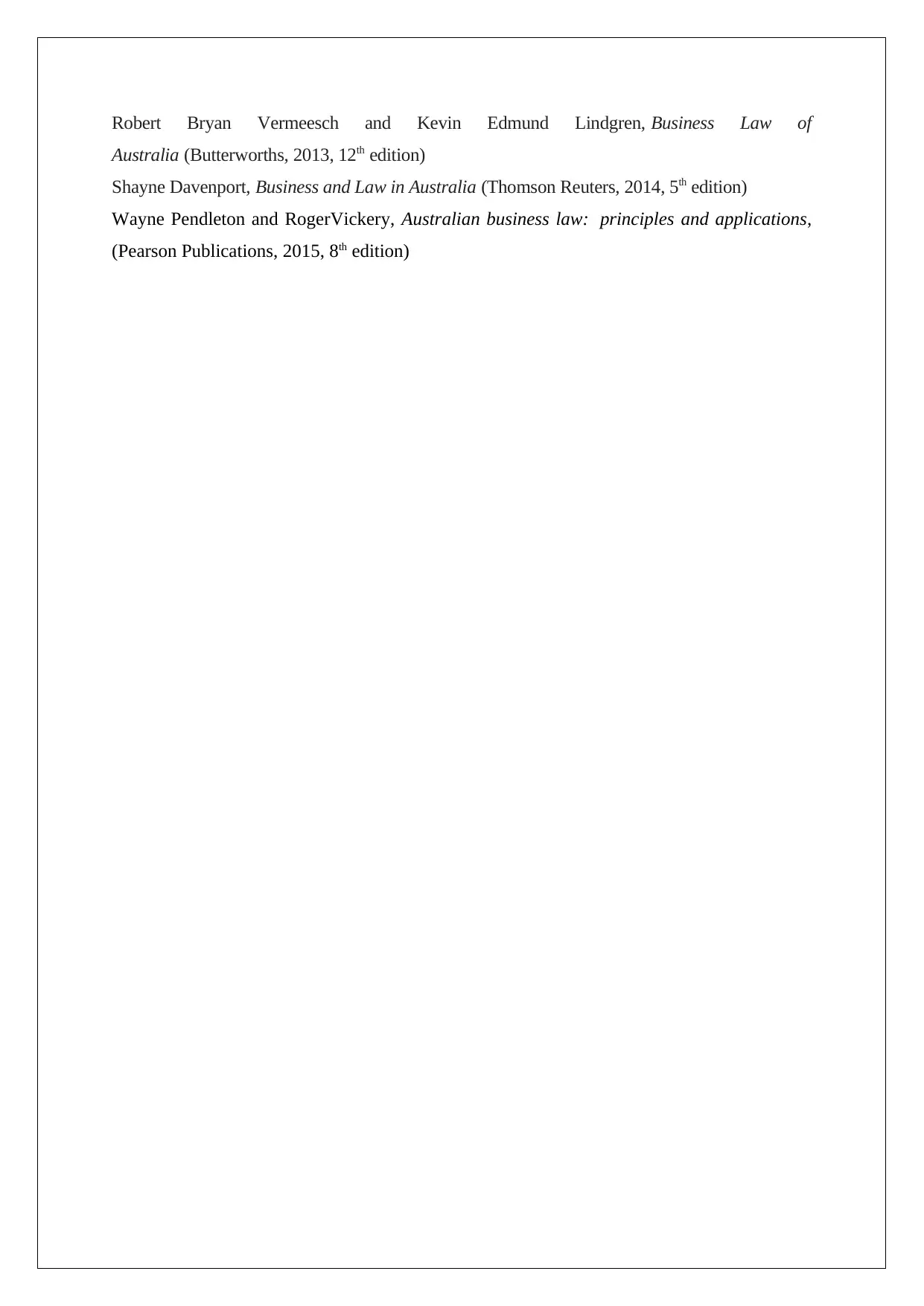
Robert Bryan Vermeesch and Kevin Edmund Lindgren, Business Law of
Australia (Butterworths, 2013, 12th edition)
Shayne Davenport, Business and Law in Australia (Thomson Reuters, 2014, 5th edition)
Wayne Pendleton and RogerVickery, Australian business law: principles and applications,
(Pearson Publications, 2015, 8th edition)
Australia (Butterworths, 2013, 12th edition)
Shayne Davenport, Business and Law in Australia (Thomson Reuters, 2014, 5th edition)
Wayne Pendleton and RogerVickery, Australian business law: principles and applications,
(Pearson Publications, 2015, 8th edition)
1 out of 7
Related Documents
Your All-in-One AI-Powered Toolkit for Academic Success.
+13062052269
info@desklib.com
Available 24*7 on WhatsApp / Email
![[object Object]](/_next/static/media/star-bottom.7253800d.svg)
Unlock your academic potential
© 2024 | Zucol Services PVT LTD | All rights reserved.





